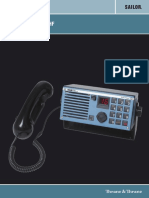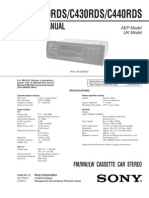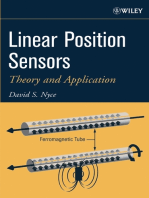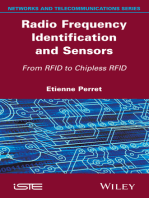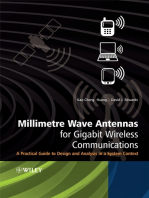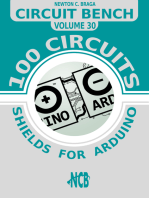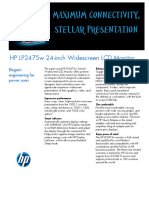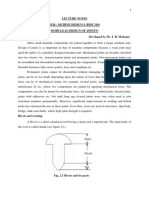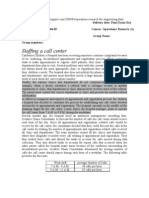HH100-HH120 English PDF
HH100-HH120 English PDF
Uploaded by
sil doroCopyright:
Available Formats
HH100-HH120 English PDF
HH100-HH120 English PDF
Uploaded by
sil doroOriginal Title
Copyright
Available Formats
Share this document
Did you find this document useful?
Is this content inappropriate?
Copyright:
Available Formats
HH100-HH120 English PDF
HH100-HH120 English PDF
Uploaded by
sil doroCopyright:
Available Formats
CONTENTS
- INTRODUCTION ......................................................................................................... page 1
- ROTOR TECHNICAL DATA ..................................................................................... page 2
- MOUNTING INSTRUCTIONS .................................................................................. page 3
1. Where to install the sat dish .................................................................................... page 3
2. Rotor’s installation .................................................................................................... page 3
3. Connections ................................................................................................................ page 4
3.1 Specifications of the recommended coaxial cable........................................... page 4
3.2 Map to determine the installation parameters - EUROPE MAP ................ page 5
NORTH AFRICA MAP ..................................................................................... page 5a
MIDDLE EAST MAP......................................................................................... page 5b
SOUTH EAST ASIA MAP ................................................................................ page 5c
4. How to find out the elevation angle of the Rotor ................................................. page 6
5. How to find out the elevation value of the dish .................................................... page 6
6. Dish pointing .............................................................................................................. page 6
10. EAST - WEST limits (only for enabled receivers) ............................................. page 9
11. Recalculation function ............................................................................................ page 9
12. Return to the 0° position of the rotor (only for enabled receivers) ................. page 10
13. Autofocus (only for enabled receivers) ................................................................ page 10
- PROBLEMS SOLVING GUIDE ................................................................................. page 11
- WARRANTY CONDITIONS ...................................................................................... page 12
- HOW TO CONTACT US ............................................................................................. page 13
Via Seminiato, 79
44031 AMBROGIO (FE) ITALY
http:// www.stab-italia.com
e-mail: info@stab-italia.com
DEAR CUSTOMER,
Congratulations! You are now the owner of STAB ROTOR SAT.
This is the first sat motor developed by STAB in cooperation with EUTELSAT in order to define the
DiSEqCTM 1.2 standard.
ROTOR SAT HH100 - HH120
Attention:
• To connect the motor without interface it is necessary that your receiver includes DiSEqCTM 1.2 protocol.
• Please read carefully this instructions manual before installing and using it.
• For the movement and memorization commands, see the receiver’s instructions manual.
The DiSEqCTM 1.2 system is a trademark of EUTELSAT.
All drawings and technical data are STABTM property and can be changed without prior notice.
Rotor Sat HH100-HH120 instructions manual – page 1
ROTOR TECHNICAL DATA
ROTOR SAT HH100 ROTOR SAT HH120
OPTIONAL
SPECIFICATIONS SPECIFICATIONS
- Operating protocol DiSEqCTM 1.2 Level - Operating protocol DiSEqCTM 1.2 Level
- Maximum antenna diameter 100 cm - Maximum antenna diameter 120 cm
- Maximum antenna weight 12 Kg - Maximum antenna weight 17 Kg
- Antenna support length 125 mm - Antenna support length 180 mm
- Rotation angle ±62° - Rotation angle ±62°
- Rotation speed 1,8°/s(18V) 1,2/s(13V) - Rotation speed 1,1°/s(18V) 0,8/s(13V)
- Operating power supply 13 / 18 Vdc - Operating power supply 13 / 18 Vdc
- Consumption in stand-by mode 30mA - Consumption in stand-by mode 30mA
- Consumption in operating mode 190mA - Consumption in operating mode 190mA
- Starting consumption max 350mA - Starting consumption max 350mA
- Operating temperature -40°C +80°C - Operating temperature -40°C +80°C
- Maximum relative humidity 100% - Maximum relative humidity 100%
- Programmable positions 49 satellites - Programmable positions 49 satellites
- Preset positions 26 satellites - Preset positions 26 satellites
- Connectors F type - Connectors F type
- Connections Sat coaxial cable - Connections Sat coaxial cable
- Mechanical limits ±70° - Mechanical limits ±70°
- Software programmable limits from 5° to 62° - Software programmable limits from 5° to 62°
- Fine tuning impulse 0,1° - Fine tuning impulse 0,1°
- Inclination max 70° - Inclination max 70°
- Weight 3 Kg - Weight 3,2 Kg
OPTION
- Extension for antenna support
Rotor Sat HH100-HH120 instructions manual – page 2
MOUNTING INSTRUCTIONS
1. Where to install the sat dish
1.1 Choose a position from where the dish can see the SOUTH without any impediments or obstructions.
Buildings, trees, water-pipes etc. can block partially or completely the sat reception.
2. Rotor’s installation
2.1 Fix the supporting pole (ø 50 ÷ 83 mm diameter) in a perfectly FIG. 1
vertical position.
2.2 Use the provided support to fix the rotor to the pole (fig. 1).
It is strictly forbidden to install the motor upside-down.
2.3 Point the rotor position to the south using a compass (fig. 2).
2.4 Assemble the dish according to the manufacturer’s instructions.
2.5 Fix the dish to the rotor’s antenna support with the provided brackets
(fig. 1).
2.6 Align the dish to rotor’s pole indicator (fig. 2 - 3).
2.7 On a coax cable approximately 1,5 m long, set up two F-connectors
(fig. 4) and connect the LNB to the rotor’s LNB plug (fig. 5 - cable 1). MINIMUM
2.8 Fit an F-connector on each end of the cable going to the receiver HEIGHT
TO AVOID
(fig. 4) and connect the rotor’s REC plug to the plug of your receiver VIBRATION
(fig. 5 - cable2).
Warning: - See cable specifications on page 4.
FIG. 2
SOUTH
FIG. 3
FIG. 4 15 mm
8 mm
F-CONNECTOR
3 mm
Rotor Sat HH100-HH120 instructions manual – page 3
3. Connections (fig. 5)
FIG. 5
RECEIVER ROTOR LNB
ANT. 2
REC LNB
ANT. 1
cable n. 2 cable n. 1
TV
cable n. 2
LNB
RECEIVER
cable n. 1
(provided)
3.1 Specifications of the recommended coaxial cable
A bad quality cable can prejudice the motor correct working!
Please follow the next specifications:
CABLE TO 30 M FROM 30 TO 60 M
LENGTH (to 98.4 feet) (from 98.4 to 196.8 feet)
Cable type sat coaxial cable sat coaxial cable
Inner conductor CU ø=1,02 mm CU ø=1,13 mm
Inner conductor resistance 22 ohm/Km 18 ohm/Km
Outside conductor resistance 22 ohm/Km 10 ohm/Km
Rotor Sat HH100-HH120 instructions manual – page 4
3.2 Map to determine the installation parameters - EUROPE MAP
LONGITUDE
L
A
T
I
T
U
D
E
Rotor Sat HH100-HH120 instructions manual – page 5
3.2 Map to determine the installation parameters - NORTH AFRICA MAP
LONGITUDE
L
A
T
I
T
U
D
E
Rotor Sat HH100-HH120 instructions manual – page 5a
3.2 Map to determine the installation parameters - MIDDLE EAST MAP
LONGITUDE
L
A
T
I
T
U
D
E
Rotor Sat HH100-HH120 instructions manual – page 5b
3.2 Map to determine the installation parameters - SOUTH EAST ASIA MAP
LONGITUDE
L
A
T
I
T
U
D
E
Rotor Sat HH100-HH120 instructions manual – page 5c
4. How to find out the elevation angle of the Rotor
4.1 Find out your own geographical position on the map on page 5, 5a, 5b, 5c, note the latitude value and
set the rotor angle to this value (fig. 6).
Example: - Venice 45,5° Latitude NORTH (fig. 6)
FIG. 6 FIG. 7
REFERENCE GRID 65
55
45 15
20
30 25
5. How to find out the elevation value of the dish
5.1 With the same latitude value, calculate the elevation of the dish (fig. 7) according to the following
formula:
Degrees of dish elevation = P – (60 – latitude)
P = degrees of dish elevation for fixed mount given by the manufacturer.
Example: - Latitude Venice = 45,5°
P (dish elevation given by the manufacturer) = 37°
Degrees of dish elevation = 37 – (60 – 45,5) = 22,5° (fig. 7)
6. Dish pointing
6.1 To point your dish easily, refer to the satellite the nearest to your longitude (see map on page 5).
6.2 Calculate the difference between the reference satellite and your position considering that:
positive values = Eastwards moving
negative values = Westwards moving
Example 1: Installation VENICE Longitude 12,3° EAST
Reference satellite ASTRA Longitude 19,2° EAST
19,2 – 12,3 = +6,9 The position of ASTRA at your location is 6,9° EAST (see fig. 8)
Example 2: Installation VENICE Longitude 12,3° EAST
Reference satellite EUTELSAT F2 Longitude 10°EAST
10 – 12,3 = –2,3 The position of EUTELSAT at your location is 2,3° WEST
6.3 With the receiver’s remote control (see receiver’s instructions FIG. 8
manual - paragraph dedicated to the motor), move the rotor by
short impulses Eastwards or Westwards to reach the calculated
value. To coordinate this operation it is necessary that the
receiver is near the dish or that somebody can assist you: while
the first one uses the remote control near the receiver, the other
one will inform when the dish has reached the correct position
on the graduated scale of the rotor.
Example: VENICE - around 6,9° EAST - (fig. 8) ex. VENICE 6,9°
Rotor Sat HH100-HH120 instructions manual – page 6
6.4 Disconnect the cable going to the receiver from the rotor and FIG. 9
connect the field-strength meter. Unscrew the bolts that hold
the rotor to the main pole and then rotate EASTWARDS or
WESTWARDS both the rotor and the dish locked together
(fig. 9 - Bolt A) until you obtain the best reception quality;
tighten then again the bolts. If you cannot use a field-strength
meter, you need anyway to place a TV near the dish to check
the image definition. Connect the rotor again.
BOLT A
6.5 Store the sat position (see receiver’s instructions manual - paragraph dedicated to the motor), then
operate a recalculation (see paragraph 11.2) (if your receiver enables this function); otherwise find
out the other sat positions and store them one by one. If the previous steps have been correctly carried
out, you should now be able to see all satellites including the lower East and West orbital ones.
If this procedure was not carried out properly, you might experience imperfect reception of the satellites
in the most eastwards and westwards positions. To correct this, you must proceed as follows: - select a
non-crypted channel on the most Eastward satellite, then bend slightly the dish upwards / downwards
without loosening any bolts and check if there is any picture improvement. Repeat the same procedure
also with the most Westward satellite. In these conditions four possible cases could occur:
Case n. 1 If there is a picture quality improvement while bending up the dish on the Eastward sat position
and bending down on the Westward sat position unscrew slightly the bracket and rotate westwards
(clockwise) the rotor and the dish locked together (fig. 11). Tighten the screws of the supporting
bracket, then correct the dish orientation and go to the reference satellite by using the receiver’s
remote control (see receiver’s instructions manual - paragraph dedicated to the motor). Find the
best picture and store the new position. Now you can operate the recalculation (if your receiver
gets the function). If not, you have to go back to each memorized position, check the best picture
and store all positions one by one.
Case n. 2 If there is a picture quality improvement while bending up the dish on the Westward sat position
and bending down on the Eastward sat position unscrew slightly the bracket and rotate eastwards
(anticlockwise) the rotor and the dish locked together (fig. 12). Tighten the screws of the supporting
bracket, then correct the dish orientation and go to the reference satellite by using the receiver’s
remote control (see receiver’s instructions manual - paragraph dedicated to the motor). Find the
best picture and store the new position. Now you can operate the recalculation (if your receiver
gets the function). If not, you have to go back to each memorized position, check the best picture
and store all positions one by one.
Case n. 3 If the picture quality improves while bending the dish Up/East on the Eastward sat position and
Up/West on the Westward sat position, you should unscrew the motor support from the pole and
lower slightly the elevation of the complete system (fig. 13). Find the best picture and store the
new position. Now you can operate the recalculation (if your receiver gets the function). If not,
you have to go back to each memorized position, check the best picture and store all positions one
by one.
Case n. 4 If the picture quality improves while bending the dish downwards/both eastwards and westwards,
you should loosen the rotor’s fixing screws and increase slightly the elevation on the bracket (fig. 14).
Find the best picture and store the new position. Now you can operate the recalculation (if your
receiver gets the function). If not, you have to go back to each memorized position, check the best
picture and store all positions one by one.
Rotor Sat HH100-HH120 instructions manual – page 7
FIG. 11
SOUTH
WRONG ORBIT
IDEAL ORBIT
E W
60° 0° 60°
BOLT A
FIG. 12
SOUTH
WRONG ORBIT
IDEAL ORBIT
E W
60° 0° 60°
BOLT A
FIG. 13
SOUTH
IDEAL ORBIT WRONG ORBIT
E W
60° 0° 60°
FIG. 14 SOUTH
WRONG ORBIT
IDEAL ORBIT
E W
60° 0° 60°
Rotor Sat HH100-HH120 instructions manual – page 8
10. EAST - WEST limits (only for enabled receivers)
10.1 The rotor is designed to rotate from 62° EAST to 62° WEST.
10.2 Two limits are set electronically at ± 65° and mechanically at ± 70° to protect the maximum rotation.
Within these limits you can though set two new electronic limits included between 5° ÷ 62° EAST and
5° ÷ 62° WEST; over these ranges the motor does not accept any memorization.
10.3 Setting the limits might become necessary if the rotor cannot perform the full rotation because of an
obstacle.
10.4 To remove, to set and to store the limits, see the receiver’s instructions manual on the paragraph dedicated
to the limits.
10.5 If not really necessary, please maintain the limits in the pre-programmed positions at ± 50°.
11. Recalculation function
11.1 The rotor includes 49 satellites positions: 26 positions are pre-set, as shown on the table below, and
23 still available.
Pos. nr. Satellite Posizione
1 ....................................HOT BIRD ....................................... 13° E
2 ....................................ASTRA 1 ...........................................19,2° E
3 ....................................EUTELSAT F3 .................................16° E
4 ....................................EUTELSAT F2 .................................10° E
5 ....................................EUTELSAT F4 .................................7° E
6 ....................................SIRIUS ..............................................5° E
7 ....................................TELECOM-2C ................................3° E
8 ....................................INTELSAT 707 ................................1° W
9 ....................................TELECOM-2B,2D........................... 5° W
10 ..................................TELECOM-2A ................................8° W
11 ..................................INTELSAT 705 ................................18° W
12 ..................................INTELSAT STAR ............................ 21° W
13 ..................................INTELSAT 803 ................................27° W
14 ..................................HISPASAT ........................................ 30° W
15 ..................................ORION ..............................................37° W
16 ..................................KOPERNICUS 3 ............................. 23° E
17 ..................................ARABSAT 2A ..................................26° E
18 ..................................ASTRA 2 ...........................................28° E
19 ..................................KOPERNICUS 2 ............................. 28° E
20 ..................................ARABSAT 2B ...................................30° E
21 ..................................TURKSAT 1B ..................................31° E
22 ..................................TURKSAT 1C ..................................42° E
23 ..................................INTELSAT 601 ................................34,5° E
24 ..................................PAS 1 .................................................45° W
25 ..................................AMOS ................................................4° W
26 ..................................THOR ................................................0,8° W
Rotor Sat HH100-HH120 instructions manual – page 9
11.2 The recalculation function automatically calculates and sets all pre-programmed satellites positions
with reference to the position of a single satellite. In other words after you have found and stored one
satellite, the recalculation procedure enables the automatic re-positioning of the other satellites inside
the rotor’s memory to a pre-defined distance, as shown on the above table.
12. Return to the 0° position of the rotor (only for enabled receivers)
12.1 This function enables the rotor to return to the 0° position and to reset the inside counter. It is very
important to re-align all satellite positions that can be slightly slided eastwards or westwards from the
reference stored positions (bad picture or lost positions).
12.2 In the receivers’ menu this function could be named as: “RE-ALIGN”, “RESET”, “GO TO POS 00”,
“REFERENCE”. In some receivers this operation is automatic.
12.3 After this command, check if the satellite positions are correct.
12.4 If this function is not implemented in your receiver, you need to connect temporarily an interface and
press the remote control buttons “FUNC and RESET”.
13 Autofocus (only for enabled receivers)
13.1. The rotor is provided with a special function called “autofocus”: this procedure allows the rotor to
focus automatically the satellites before storing. Only some receivers are provided with this command.
Rotor Sat HH100-HH120 instructions manual – page 10
PROBLEMS SOLVING GUIDE
WARNING! NEVER SWITCH OFF THE RECEIVER WHILE THE MOTOR IS MOVING TO
AVOID THE LOSS OF ALIGNMENT.
PROBLEM CAUSE REMEDY
1. The rotor does not rotate. • The receiver is blocked. • Reset the receiver or discon-
nect it from the mains for 30
• Oxidised connectors. seconds.
. • Substitute connectors.
• Coaxial cable badly wired. • Check F connections on the
cable (fig. 4).
2. The rotor slightly exceeds the • The receiver has been switched • Send re-alignment command
stored sat positions (disturbed off many times while the rotor (par. 12).
pictures). was moving. • Find a satellite and operate the
3. The rotor lost all satellites • Electrical micro-interruptions. re-calculation function (only
positions (no picture). • The rotor received a command for enabled receivers, par. 11),
4. The rotor is blocked at the wrongly. or store again all sat positions
extremes. • The receiver sent a wrong command. one by one.
5. The rotor does not rotate • A limit has been set and stored on • Remove the limits and store them
beyond a certain position. this position. again in more appropriate posi-
tions (par. 10).
6. The rotor does not focus the • The dish pointing procedure was • Repeat dish pointing procedure
sat positions even after the not carried out correctly. following carefully the instruc-
recalculation procedure (only tions on page 6 - parag. 6 “DISH
for enabled receivers). POINTING”.
7. Extreme East/West satellites • Wrong setting of rotor’s elevation • Repeat more carefully the pro-
signals are not received. angle. cedures on page 6, paragraphs
8. Central satellites signals are 4, 5, 6.
not received.
Rotor Sat HH100-HH120 instructions manual – page 11
WARRANTY CONDITIONS
This rotor is produced and tested by our laboratory with extreme care and carries a warranty for 12 months
from purchase date.
A copy of the shop receipt or the invoice represent the warranty document and must be sent together with
the set when returned. This warranty covers all production defects and working faults, but excludes all
damages caused by drops, incorrect use or external oxidations due to incorrect installation. Any repair
made by unauthorised personnel will automatically cancel this warranty.
Rotor Sat HH100-HH120 instructions manual – page 12
For further information and advices about installation and uses contact
YOUR LOCAL DEALER
or
STAB Technical Office:
Via Seminiato, 79 - 44031 AMBROGIO (FERRARA) - ITALY
Local time 8.00 to 12.00 a.m. and 1.30 to 5.30 p.m. (MIDDLE EUROPE time)
Phone +39-0532-830739 Fax +39-0532-830609
http//: www.stab-italia.com
www.stab-italia.com e-mail:
e-mail:sandro@stab-italia.com
sandro@stab-italia.com
BACK TO THE CONTENTS TABLE
Rotor Sat HH100-HH120 instructions manual – page 13
You might also like
- Plant MaintenanceDocument18 pagesPlant MaintenanceSalim82 LK100% (6)
- Kubota L3560 - L4060 - L4760 - L5060 - L5460 - L6060 Tractor Operators Manual (2020 - 06 - 18 03 - 32 - 31 UTC)Document22 pagesKubota L3560 - L4060 - L4760 - L5060 - L5460 - L6060 Tractor Operators Manual (2020 - 06 - 18 03 - 32 - 31 UTC)Charles CampbellNo ratings yet
- RCI-6900F HP-TB Service ManualDocument41 pagesRCI-6900F HP-TB Service Manualbellscb100% (2)
- Service Manual RCI 6900F150 ENG PDFDocument41 pagesService Manual RCI 6900F150 ENG PDFRichardson Almeida0% (1)
- Sailor RT2048 (Original Vector Schematic + Improved Bitmap Schematic of The Synth.) PDFDocument86 pagesSailor RT2048 (Original Vector Schematic + Improved Bitmap Schematic of The Synth.) PDFVasil StoianovNo ratings yet
- B800-1 ManualEDocument35 pagesB800-1 ManualESLAMET PAMBUDI100% (1)
- Ic F3022SDocument36 pagesIc F3022SEfren.galNo ratings yet
- Icom IC-M45 Service ManualDocument30 pagesIcom IC-M45 Service ManualGanifianto RasyidNo ratings yet
- IC-GM1600 Service ManualDocument34 pagesIC-GM1600 Service ManualИгорь100% (1)
- KX-TG4061 Service ManualDocument98 pagesKX-TG4061 Service ManualtsromailNo ratings yet
- Service Manual: VHF FM TransceiversDocument7 pagesService Manual: VHF FM Transceiversสด H826No ratings yet
- RCI-6300F HPTB Service ManualDocument45 pagesRCI-6300F HPTB Service ManualbellscbNo ratings yet
- Fr-1510ds 1530ds Marine Radar Sme-A 129Document129 pagesFr-1510ds 1530ds Marine Radar Sme-A 129gitlatsubNo ratings yet
- VHF Marine Transceiver: Downloaded From Manuals Search EngineDocument7 pagesVHF Marine Transceiver: Downloaded From Manuals Search EngineKo AzaniNo ratings yet
- F70 Service ManualDocument42 pagesF70 Service ManualReegen GuiseNo ratings yet
- Trimble SPS 852 GNSS Modular ReceiverDocument2 pagesTrimble SPS 852 GNSS Modular ReceiverMuhammad 'Izza FuadiNo ratings yet
- Service Manual: Mini Component Sound SystemDocument44 pagesService Manual: Mini Component Sound SystemAndres Florentin Pizarro Lazarte100% (1)
- Icom IC-R75 Service ManualDocument51 pagesIcom IC-R75 Service ManualYayok S. AnggoroNo ratings yet
- Sony hcd-fc8, fc9 PDFDocument140 pagesSony hcd-fc8, fc9 PDFRaymundo Moran LopezNo ratings yet
- Assembly & Operations Manual: Digital Vector RF WattmeterDocument50 pagesAssembly & Operations Manual: Digital Vector RF WattmeterYuriy GoncharukNo ratings yet
- Ty Series RTP Series Datasheet 32307665 B en Ciid 154842Document9 pagesTy Series RTP Series Datasheet 32307665 B en Ciid 154842Jonas OliveiraNo ratings yet
- AWT2-3910Document6 pagesAWT2-3910yoann.lefebvreNo ratings yet
- TV Sylvania Mod. 6477ffDocument53 pagesTV Sylvania Mod. 6477ffpata saladaNo ratings yet
- Icom IC-2710H Service ManualDocument48 pagesIcom IC-2710H Service ManualclaudioNo ratings yet
- Posicionadores Centac ViejosDocument13 pagesPosicionadores Centac Viejosalexander3233No ratings yet
- VHF Transceiver: S-14708XZ-C1 Sep. 2010Document29 pagesVHF Transceiver: S-14708XZ-C1 Sep. 2010Kien NguyenNo ratings yet
- Icom ICV8Document31 pagesIcom ICV8john solasNo ratings yet
- HWSC S A0001791914 1Document10 pagesHWSC S A0001791914 1Ganesh SainavarapuNo ratings yet
- AWT2-3910 (1)Document9 pagesAWT2-3910 (1)yoann.lefebvreNo ratings yet
- Service Manual: Uhf TransceiverDocument40 pagesService Manual: Uhf TransceiveryulkifliNo ratings yet
- FT 901 ServiceDocument199 pagesFT 901 ServicetoolmastermtNo ratings yet
- DS7037 Issue 1 (1) .2 (Kathrein 88 Deg Multiband 2.0 and 2.6m VET Antenna)Document2 pagesDS7037 Issue 1 (1) .2 (Kathrein 88 Deg Multiband 2.0 and 2.6m VET Antenna)shahaab786No ratings yet
- Sony CFD-G700CP-G770CP-G-770CPKDocument70 pagesSony CFD-G700CP-G770CP-G-770CPKvideoson100% (1)
- XR 4740rdsDocument52 pagesXR 4740rdslijhubNo ratings yet
- Model 851 Mark-2 Marine Radar Sme 34900a 58Document58 pagesModel 851 Mark-2 Marine Radar Sme 34900a 58gitlatsubNo ratings yet
- JVC LCD Lt-26a70bj - Lt-32a70s Chassis Ft2Document56 pagesJVC LCD Lt-26a70bj - Lt-32a70s Chassis Ft2ngoclinhdtddNo ratings yet
- Manual Servicio JVC UX-G45BDocument41 pagesManual Servicio JVC UX-G45Bschumi_kaiserNo ratings yet
- Ic f7000 Service Manual HflinkDocument55 pagesIc f7000 Service Manual HflinkAltin HoxhaNo ratings yet
- Funai 24FL553P10 Schematic and Manual PDFDocument42 pagesFunai 24FL553P10 Schematic and Manual PDFMOREIRA ITHANNo ratings yet
- user-manual-12012_(manymanuals.com)Document11 pagesuser-manual-12012_(manymanuals.com)pucknbassNo ratings yet
- Service Manual JVC UX-N1WDocument49 pagesService Manual JVC UX-N1Wcesar sNo ratings yet
- Manual IC F4013 PDFDocument32 pagesManual IC F4013 PDFFabián Peña AlvearNo ratings yet
- RCI 2950DX 2970DX Service ManualDocument44 pagesRCI 2950DX 2970DX Service Manualbellscb100% (2)
- VHF Marine Transceiver: S-14720XZ-C1 Apr. 2011Document27 pagesVHF Marine Transceiver: S-14720XZ-C1 Apr. 2011song_trangNo ratings yet
- Funai 32fl553p.10 32fl553.10 Service ManualDocument42 pagesFunai 32fl553p.10 32fl553.10 Service ManualAchim F.No ratings yet
- m45 Manual e PDFDocument30 pagesm45 Manual e PDFBj Santoso Tanjung Perak - ydthreebejNo ratings yet
- Icom IC-4008A-MK2 Service ManualDocument31 pagesIcom IC-4008A-MK2 Service ManualYayok S. AnggoroNo ratings yet
- Icom IC-M710RT ServDocument73 pagesIcom IC-M710RT ServAkhil ViswanathanNo ratings yet
- Ic703 ServiceDocument57 pagesIc703 Servicewalters2No ratings yet
- User Manual 1746242Document5 pagesUser Manual 1746242AlexanderNo ratings yet
- Electrical Data: (Basta)Document2 pagesElectrical Data: (Basta)Anonymous ZlPONG100% (2)
- GD-21 RosenbergerDocument2 pagesGD-21 RosenbergerВадим ЧеховскийNo ratings yet
- Reference Guide To Useful Electronic Circuits And Circuit Design Techniques - Part 2From EverandReference Guide To Useful Electronic Circuits And Circuit Design Techniques - Part 2No ratings yet
- Analog Dialogue, Volume 48, Number 1: Analog Dialogue, #13From EverandAnalog Dialogue, Volume 48, Number 1: Analog Dialogue, #13Rating: 4 out of 5 stars4/5 (1)
- Delco Manuals: Radio Model 633, Delcotron Generator Delco Radio Owner's Manual Model 633, Delcotron Generator InstallationFrom EverandDelco Manuals: Radio Model 633, Delcotron Generator Delco Radio Owner's Manual Model 633, Delcotron Generator InstallationNo ratings yet
- Radio Frequency Identification and Sensors: From RFID to Chipless RFIDFrom EverandRadio Frequency Identification and Sensors: From RFID to Chipless RFIDNo ratings yet
- Delco Radio Owner's Manual Model 633; Delcotron Generator InstallationFrom EverandDelco Radio Owner's Manual Model 633; Delcotron Generator InstallationNo ratings yet
- Millimetre Wave Antennas for Gigabit Wireless Communications: A Practical Guide to Design and Analysis in a System ContextFrom EverandMillimetre Wave Antennas for Gigabit Wireless Communications: A Practical Guide to Design and Analysis in a System ContextNo ratings yet
- Radio Shack TRS-80 Expansion Interface: Operator's Manual Catalog Numbers: 26-1140, 26-1141, 26-1142From EverandRadio Shack TRS-80 Expansion Interface: Operator's Manual Catalog Numbers: 26-1140, 26-1141, 26-1142No ratings yet
- Thinkpad Port Replicator Series 3 With Usb 3.0: Product DescriptionDocument2 pagesThinkpad Port Replicator Series 3 With Usb 3.0: Product Descriptionsil doroNo ratings yet
- HyperX Impact USDocument2 pagesHyperX Impact USsil doroNo ratings yet
- Maximum Connectivity, Stellar Presentation: HP LP2475w 24-Inch Widescreen LCD MonitorDocument2 pagesMaximum Connectivity, Stellar Presentation: HP LP2475w 24-Inch Widescreen LCD Monitorsil doroNo ratings yet
- Nokia Bluetooth Headset BH-219: Issue 2.0Document14 pagesNokia Bluetooth Headset BH-219: Issue 2.0sil doroNo ratings yet
- Nokia Bluetooth Headset BH-222: Issue 1.0 ENDocument17 pagesNokia Bluetooth Headset BH-222: Issue 1.0 ENsil doroNo ratings yet
- This Is An Az-Box User Guide: Put Together With Information by Numerous Az-Box UsersDocument56 pagesThis Is An Az-Box User Guide: Put Together With Information by Numerous Az-Box Userssil doroNo ratings yet
- Pure and Applied ChemistryDocument21 pagesPure and Applied Chemistrymwalemarriam75No ratings yet
- P4 TutorialDocument107 pagesP4 TutorialEder Ollora ZaballaNo ratings yet
- The Role of Communication in Contemporary MarketingDocument4 pagesThe Role of Communication in Contemporary MarketingdanookyereNo ratings yet
- 10 Kinds of Disinfectants of PigsDocument3 pages10 Kinds of Disinfectants of PigsAustin DrykeNo ratings yet
- Chilled Water Fan Coil UnitPart-11Document1 pageChilled Water Fan Coil UnitPart-11Enak CenirNo ratings yet
- 2 0722 Aircraft Application GuideDocument5 pages2 0722 Aircraft Application GuideArturo RiveroNo ratings yet
- specs_carsDocument34 pagesspecs_carsissacmartinez041691No ratings yet
- Thesis For Reign of TerrorDocument4 pagesThesis For Reign of TerrorBuyingEssaysOnlineNewark100% (2)
- ChungKaiLai 2001 Chapter1DistributionF ACourseInProbabilityTDocument15 pagesChungKaiLai 2001 Chapter1DistributionF ACourseInProbabilityTMelody WhelanNo ratings yet
- Switching Architecture E4-E5 FinalDocument20 pagesSwitching Architecture E4-E5 FinalManoj BorahNo ratings yet
- Brgy. Alang-Alang, Capitol Site, Borongan City 6800: Division of Eastern SamarDocument5 pagesBrgy. Alang-Alang, Capitol Site, Borongan City 6800: Division of Eastern SamarRaquelNo ratings yet
- Basic Logic GatesDocument14 pagesBasic Logic GatesMarryShailaine CletNo ratings yet
- Chapter 2Document58 pagesChapter 2ngonh.nguyenhuyNo ratings yet
- Bhel SipDocument60 pagesBhel SipKhalid HussainNo ratings yet
- The Money MagnetDocument42 pagesThe Money MagnetVincent67% (3)
- Sample Business Plan Guide Animestore 150314224859 Conversion Gate01Document27 pagesSample Business Plan Guide Animestore 150314224859 Conversion Gate01Madz Maits100% (1)
- AUXINSDocument28 pagesAUXINSdewifirNo ratings yet
- Multiplicative CalculusDocument13 pagesMultiplicative CalculusJohnbrown1112No ratings yet
- Did Jesus Claim To Be GodDocument4 pagesDid Jesus Claim To Be GodServantNo ratings yet
- BA Sauer 90R100 H1 enDocument60 pagesBA Sauer 90R100 H1 enTecnico Carretillas Bi BatNo ratings yet
- Firman 2Document9 pagesFirman 2Fajar hidayantoNo ratings yet
- Rivets and Welded JointDocument37 pagesRivets and Welded JointJohn Kris San LuisNo ratings yet
- Staffing A Call CenterDocument3 pagesStaffing A Call CenterDanny Stephan0% (1)
- Downloader - Ashx 2Document43 pagesDownloader - Ashx 2harrishameed446No ratings yet
- Partition of Slag Phases in The Treatment and Pouring of Ductile IronDocument2 pagesPartition of Slag Phases in The Treatment and Pouring of Ductile Ironarnaldorcr8646No ratings yet
- Garland Pose (Malasana) - HipsDocument4 pagesGarland Pose (Malasana) - HipsTomas1122No ratings yet
- Unit 1 - Charge Formation SlideDocument9 pagesUnit 1 - Charge Formation SlideSanthiya TNo ratings yet
- Handbook of Equine Emergencies (VetBooks - Ir)Document432 pagesHandbook of Equine Emergencies (VetBooks - Ir)Thiago OliveiraNo ratings yet




